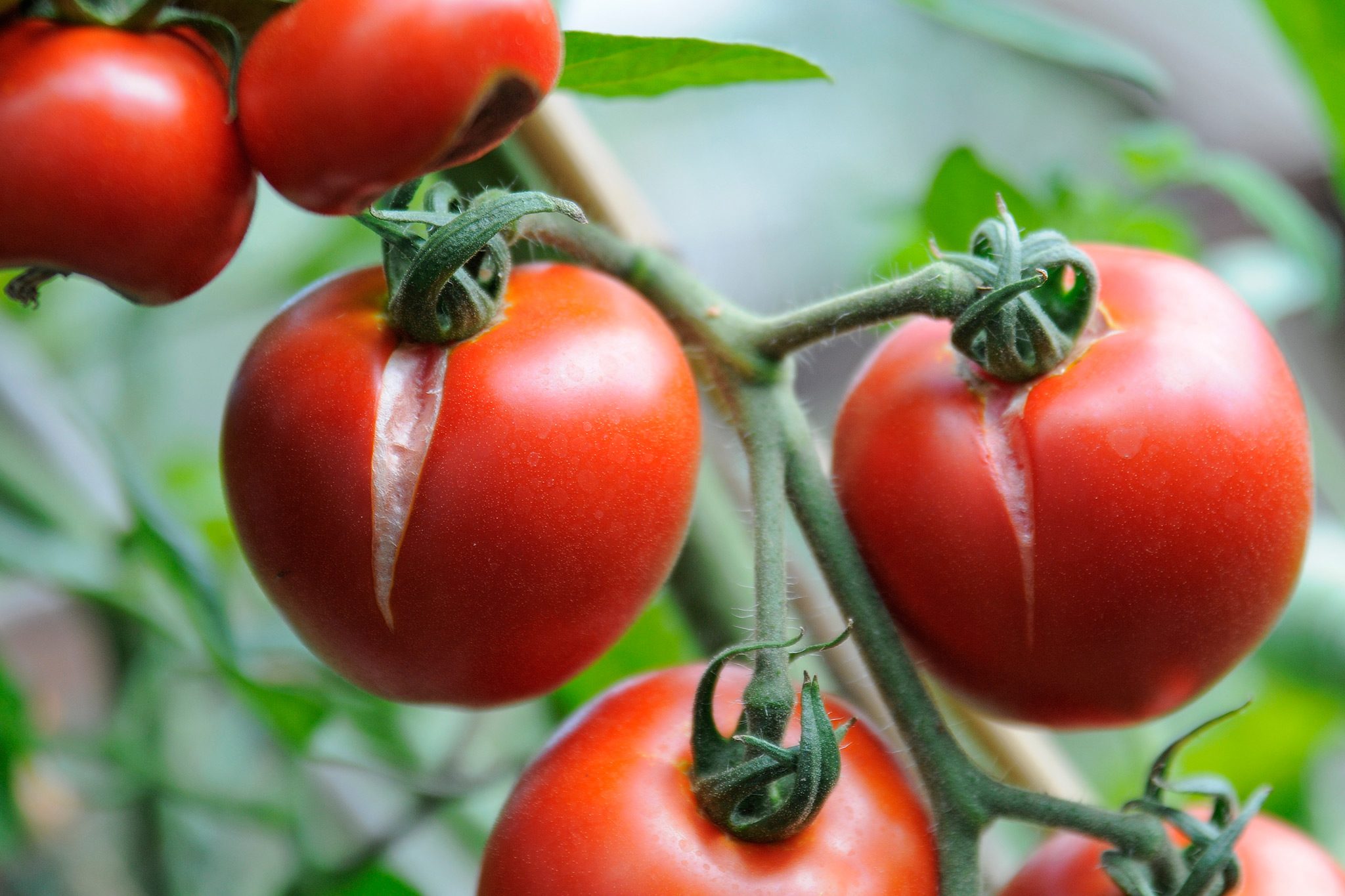In this article, we will explore the perplexing phenomenon of tomatoes splitting on the plant. This issue has left gardeners scratching their heads and wondering what could possibly be causing their prized tomatoes to develop unsightly cracks. By examining the various factors that contribute to this problem, including environmental conditions and cultural practices, we aim to shed light on the underlying causes and provide valuable insights for tomato enthusiasts seeking to prevent this frustrating occurrence in their own gardens.
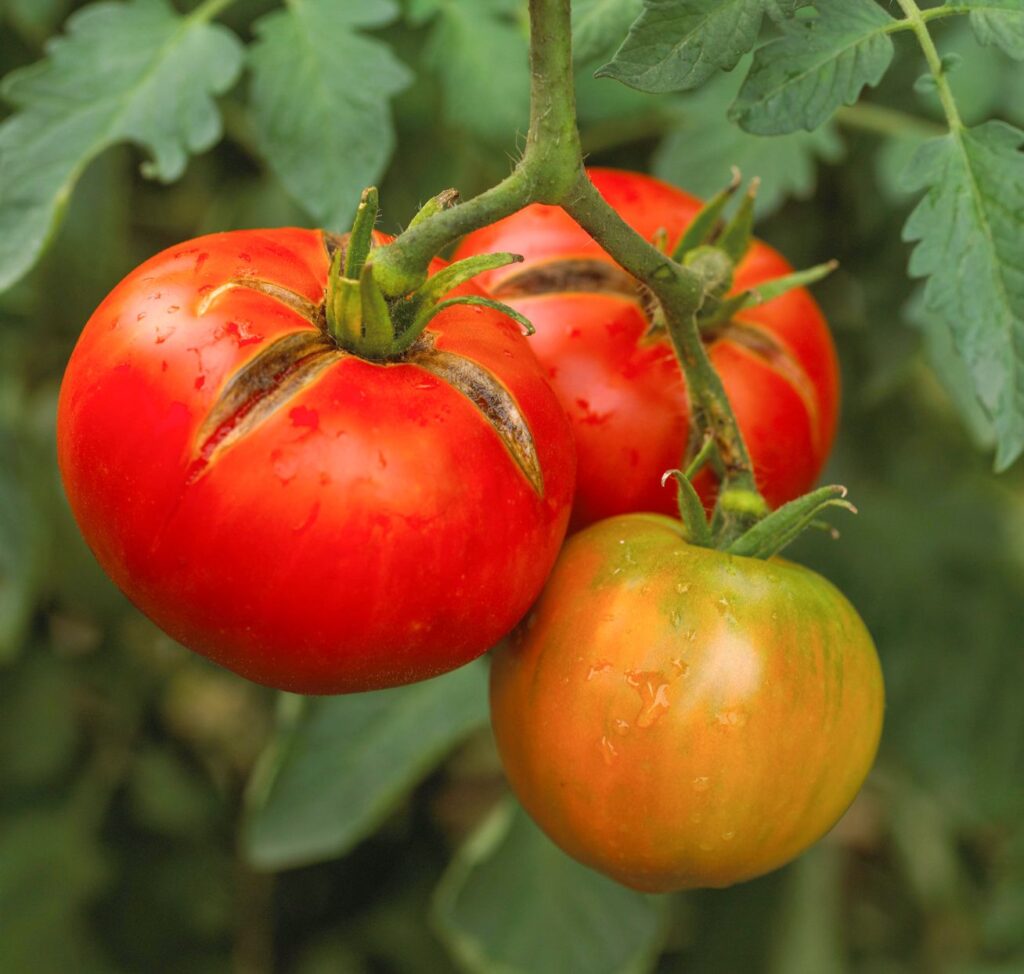
Reasons for Tomato Splitting
Tomato splitting refers to the phenomenon where tomatoes develop cracks or fissures on their skins while still on the plant. It is a common problem experienced by tomato growers, and several factors can contribute to this occurrence. By understanding the reasons behind tomato splitting, gardeners can take proactive measures to prevent and manage this issue, thus ensuring a bountiful harvest of healthy, intact tomatoes.
Overwatering
Overwatering is one of the primary culprits behind tomato splitting. When tomato plants receive excessive amounts of water, especially during the ripening stage, the fruits absorb more water than they can handle. Consequently, the internal pressure exerted by the excess water forces the skin to expand rapidly, leading to cracking. This phenomenon is particularly prevalent in indeterminate varieties, where excessive vegetative growth may contribute to water stress in the fruits.
Underwatering
Contrary to popular belief, underwatering can also trigger tomato splitting. Insufficient watering during the growing season causes the tomato plants to undergo periods of stress, making them more susceptible to cracking as the fruits rapidly absorb water when irrigation is finally provided. This can occur when gardeners unintentionally neglect to water their tomato plants regularly or provide inadequate amounts of water.
Inconsistent watering
Inconsistent watering practices, characterized by irregular intervals or fluctuations in the amount of water provided to tomato plants, can result in fruit cracking. Plants that experience alternating cycles of drought and excessive watering struggle to adapt, leading to uneven water absorption within the fruits. Consequently, the uneven distribution of moisture creates tension within the tomato skin, which ultimately leads to splitting.
Rapid fruit growth
Tomato fruits grow rapidly, particularly during warm and humid conditions. When this growth occurs at a rapid pace, the outer skin may not be able to stretch sufficiently to accommodate the internal expansion, resulting in cracks. Fast fruit growth is often associated with a sudden influx of available nutrients or excessive fertilization, prompting the plants to direct their energy towards fruit development.
Extreme temperature fluctuations
Tomatoes are sensitive to extreme temperature fluctuations, especially during the ripening stage. When tomatoes experience sudden shifts in temperature, such as hot days followed by cool nights, the skin may expand and contract at different rates. This disparity in expansion and contraction can cause the skin to rupture, leading to splitting. Temperature fluctuations are most commonly observed in regions with erratic weather patterns or during transitional seasons.
Calcium deficiency
Calcium is an essential nutrient for tomato plants, and its deficiency can contribute to fruit splitting. Insufficient calcium availability or poor calcium uptake within the plant can weaken the cell walls in tomatoes, making them more prone to cracking. This deficiency is often exacerbated by inconsistent watering practices, as calcium requires adequate moisture to be transported effectively to the fruits.
Uneven ripening
Uneven ripening, where tomatoes ripen at different rates, is another factor that can lead to splitting. When some fruits on the same plant are still in the early stages of ripening while others have reached their full maturity, the unripe tomatoes may be more prone to splitting due to their less resilient skin. The pressure exerted by the ripened fruits can also create stress on the unripe tomatoes, causing them to crack.
Variety of tomato
The choice of tomato variety itself can influence the likelihood of splitting. Some varieties have thicker, more robust skins that offer better protection against splitting, while others have more delicate skins that are more susceptible to cracking. When selecting tomato varieties, it is advisable to opt for those less prone to splitting, especially if a history of splitting has been observed in a particular garden or region.
Insect or pest damage
Insect or pest damage can weaken the skin of tomatoes, making them more susceptible to splitting. In situations where tomatoes are subject to nibbling or puncturing by pests such as slugs, snails, or birds, the compromised skin becomes prone to cracking as the fruits continue to grow and expand. Proper pest management, such as employing physical or organic deterrents, can help minimize the risk of insect-induced splitting.
Diseases
Various diseases can lead to tomato splitting by compromising the structural integrity of the fruits. Fungal infections, such as blossom end rot or anthracnose, can weaken the skin and predispose tomatoes to cracking. Bacterial infections, like bacterial canker or bacterial spot, can also contribute to fruit splitting by damaging the tissues and creating entry points for pathogens. Timely disease prevention and treatment measures, including proper sanitation and the use of fungicides or bactericides, are crucial for mitigating the risk of disease-induced splitting in tomatoes.
Overwatering
Effects of overwatering
Overwatering tomato plants can result in several detrimental effects, including tomato splitting. When plants receive excess water, it not only leads to fruit cracking but also increases the risk of fungal diseases, such as Fusarium wilt or root rot. Additionally, overwatering can lead to nutrient leaching and oxygen deprivation in the root zone, negatively affecting plant growth and overall health.
How to prevent overwatering
To prevent overwatering and minimize the risk of tomato splitting, gardeners should adhere to proper watering practices. It is recommended to water tomato plants deeply and infrequently rather than providing shallow and frequent irrigation. This approach encourages the development of deep root systems, making the plants more resilient to water stress. Additionally, the use of moisture meters or regularly monitoring soil moisture levels can help gardeners gauge when watering is necessary without overdoing it.
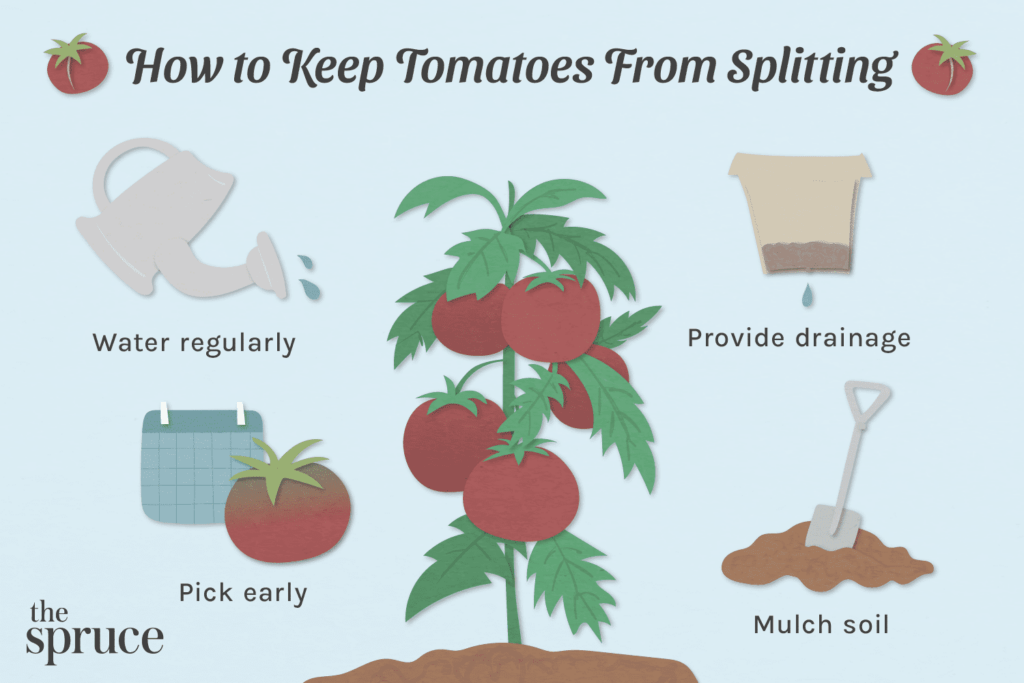
Underwatering
Effects of underwatering
Underwatering tomato plants can have detrimental effects on plant health and contribute to fruit splitting. Insufficient water supply leads to reduced plant vigor, stunted growth, and decreased fruit quality. In the case of tomatoes, underwatering during the ripening stage can cause the fruits to absorb water rapidly when irrigation is eventually provided, resulting in splitting.
How to prevent underwatering
To prevent underwatering and minimize the risk of tomato splitting, gardeners should establish a regular watering routine and ensure that the plants receive adequate moisture. The frequency and amount of watering may vary depending on environmental conditions, soil type, and stage of plant growth. Regular monitoring of soil moisture levels and observing plant indicators, such as wilting or drooping leaves, can help determine when irrigation is necessary. Mulching around the plants can also help retain soil moisture and reduce the need for frequent watering.
Inconsistent Watering
Effects of inconsistent watering
Inconsistent watering practices can lead to various adverse effects on tomato plants, including fruit splitting. When plants experience irregular intervals or fluctuations in water availability, it disrupts their ability to regulate water uptake and hydration. This inconsistency in moisture levels within the fruits can cause the skin to crack as a result of uneven expansion and contraction.
How to ensure consistent watering
To ensure consistent watering and minimize the risk of tomato splitting, gardeners should establish a watering schedule that provides a steady supply of moisture to the plants. This involves watering at regular intervals, taking into account the prevailing weather conditions and the specific needs of the tomato variety being grown. Using techniques such as drip irrigation or soaker hoses can also help deliver water directly to the root zone, promoting even and efficient hydration.

Rapid Fruit Growth
Effects of rapid fruit growth
Rapid fruit growth in tomatoes can put strain on the skin, leading to splitting. When the fruits grow quickly, the skin may not have sufficient time or elasticity to stretch and accommodate the internal expansion. As a result, cracks and fissures can develop, rendering the tomato susceptible to pathogens and decay.
How to manage rapid fruit growth
Proper management of rapid fruit growth can help minimize the occurrence of tomato splitting. Pruning tomato plants to control excess vegetative growth can redirect the plant’s energy towards fruit development, ensuring a more balanced growth rate. Additionally, regular fertilization with an appropriate balance of nutrients, such as nitrogen and potassium, can promote steady fruit development without triggering excessive growth. Monitoring the fruit’s growth and considering the specific needs of the tomato variety can guide gardeners in managing rapid fruit development.
Extreme Temperature Fluctuations
Effects of temperature fluctuations
Extreme temperature fluctuations pose significant challenges to tomatoes, potentially resulting in fruit splitting. When tomatoes are exposed to rapid shifts between hot and cold temperatures, their skins undergo differential expansion and contraction. This discrepancy in rates can create tension within the fruits and ultimately lead to cracks.
How to protect tomatoes from extreme temperatures
Protecting tomatoes from extreme temperature fluctuations is crucial for preventing fruit splitting. The use of protective measures, such as row covers, cloches, or tunnels, can shield the plants from sudden temperature changes and provide a more stable microclimate. Additionally, employing mulch around the plants can help regulate soil temperature and mitigate the impact of hot or cold spells. Choosing tomato varieties that are better adapted to local weather conditions and considering planting locations that offer partial shade can also help minimize the risk of temperature-induced splitting.
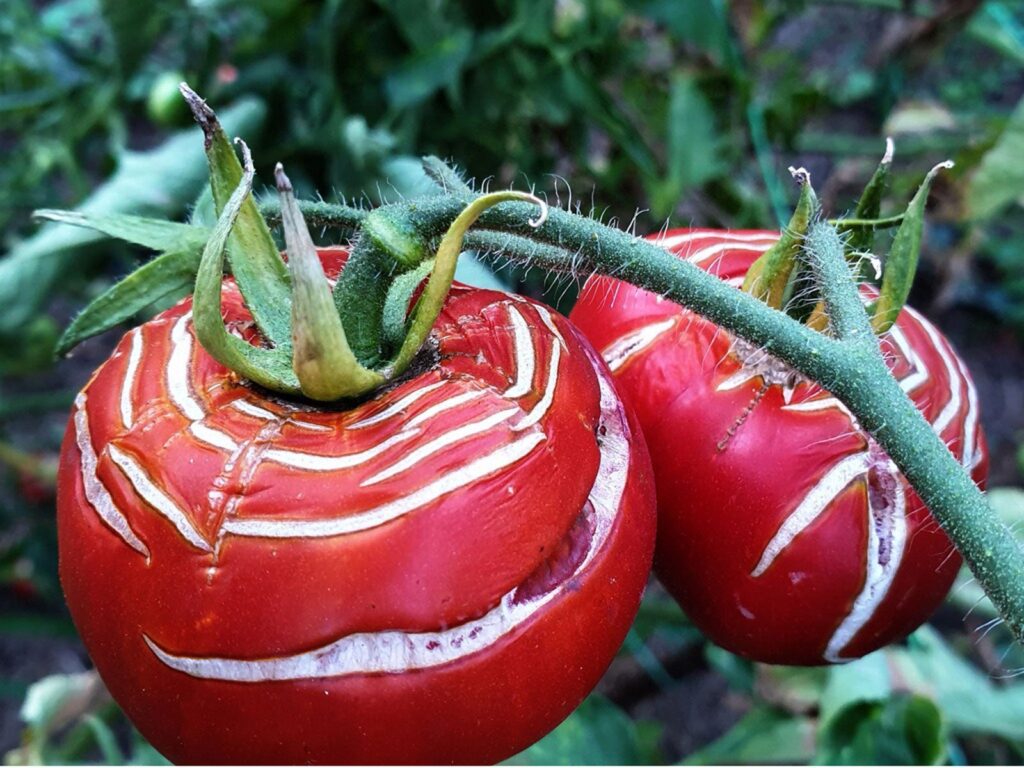
Calcium Deficiency
Effects of calcium deficiency in tomatoes
Calcium deficiency in tomatoes can have deleterious effects on fruit quality and increase the likelihood of splitting. Insufficient calcium availability or poor uptake within the plant can result in weakened cell walls, making the fruits more susceptible to cracking. Blossom end rot, a common symptom of calcium deficiency, is a disorder characterized by dark, leathery patches that can precede splitting.
How to prevent calcium deficiency
Preventing calcium deficiency is essential for minimizing the risk of tomato splitting. Ensuring proper soil fertility and pH levels is crucial, as calcium uptake is influenced by soil conditions. Applying calcium-rich amendments or fertilizers, such as gypsum or calcium nitrate, before planting or during the growing season can help maintain adequate calcium levels. Proper watering practices, avoiding excessive or uneven watering, also play a significant role in preventing calcium deficiency symptoms in tomatoes.
Uneven Ripening
Causes of uneven ripening
Uneven ripening in tomatoes can contribute to fruit splitting. When tomatoes on the same plant ripen at different rates, unripe fruits may be more prone to splitting. The pressure exerted by the previously ripened fruits can create stress on the less mature tomatoes, leading to cracking.
How to promote even ripening
Promoting even ripening in tomatoes can help reduce the risk of fruit splitting. Regularly inspecting the plants and harvesting ripe fruits in a timely manner can prevent the accumulation of pressure and stress on the remaining tomatoes. Providing optimal growing conditions, such as adequate sunlight, proper nutrient availability, and consistent watering practices, can also contribute to more synchronized ripening. Some gardeners use ethylene-producing fruits, such as bananas, to encourage the ripening process and maintain uniformity among the tomatoes.
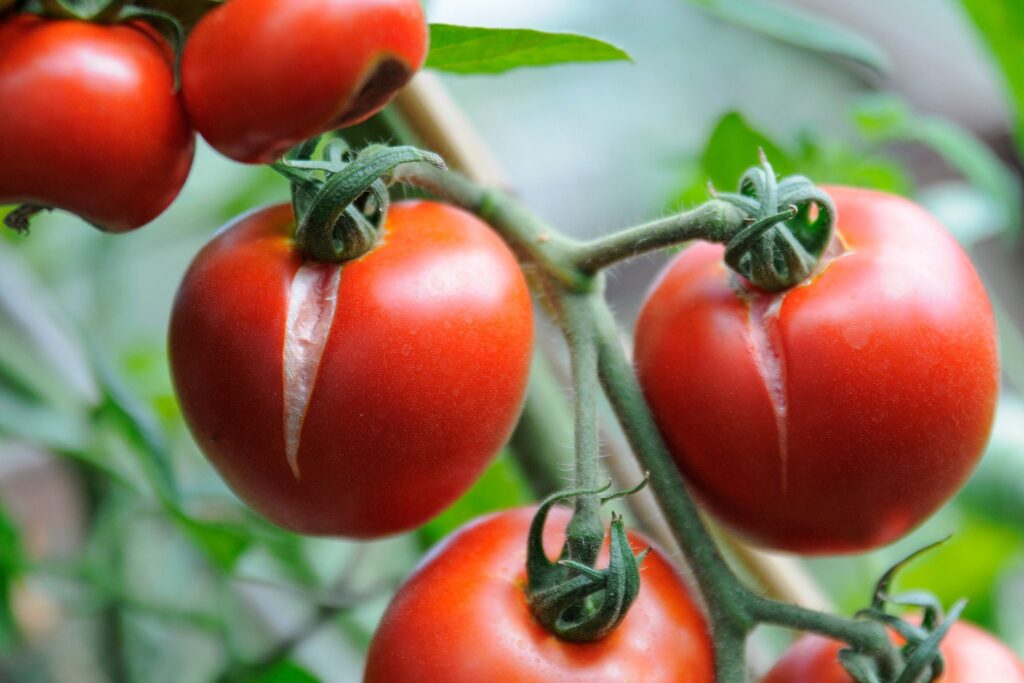
Variety of Tomato
Impact of tomato variety on splitting
The choice of tomato variety can significantly impact the likelihood of splitting. Some tomato varieties naturally possess thicker, more resilient skin, providing enhanced protection against cracking. Conversely, certain varieties may have thinner or more delicate skins, making them more susceptible to splitting under similar conditions.
Choosing tomato varieties less prone to splitting
When aiming to minimize the risk of tomato splitting, gardeners should consider selecting tomato varieties known for their resistance to cracking. Varieties specifically bred for quality attributes, including resistance to splitting, are available and can be a valuable addition to any tomato garden. Consulting local experts, nurseries, or seed catalogs can help identify suitable tomato varieties that are less prone to splitting.
Diseases
Common diseases causing tomato splitting
Various diseases can contribute to the occurrence of tomato splitting. Fungal infections, such as blossom end rot or anthracnose, can weaken the fruit’s structural integrity, making them more susceptible to cracking. Bacterial infections, like bacterial canker or bacterial spot, can also create entry points for pathogens and compromise the tomato’s skin, exacerbating the likelihood of splitting.
Preventing and treating diseases in tomatoes
Preventing and treating diseases in tomatoes are essential steps in reducing the risk of tomato splitting. Implementing preventive measures, such as practicing good sanitation, ensuring proper air circulation around the plants, and employing crop rotation, can minimize the incidence of diseases caused by fungal or bacterial pathogens. Early detection of symptoms and prompt treatment with appropriate fungicides or bactericides can help manage diseases effectively and reduce the likelihood of fruit splitting.
In conclusion, understanding the various reasons behind tomato splitting is vital for gardeners seeking to maintain high-quality tomato harvests. Overwatering, underwatering, inconsistent watering, rapid fruit growth, extreme temperature fluctuations, calcium deficiency, uneven ripening, variety selection, insect or pest damage, and diseases can all contribute to this phenomenon. By implementing appropriate preventive practices and taking timely corrective measures, gardeners can minimize the occurrence of tomato splitting and enjoy healthy, intact tomatoes throughout the growing season.
